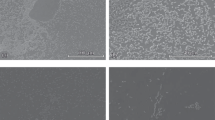Abstract
A total of 2087Pseudomonas aeruginosa isolates collected during the period 1994–1997 were used as starting material. Out of 1704 in-patient isolates, 299 strains were selected for the preparation of phage lysates but only five strains provided stable lysates,i.e., maintained the ability to be repeatedly and completely lysed by the appropriate phage in the course of several years. A set of 193 out-patients (189) and water sources (4) isolates failed to yield strains suitable for phage lysate preparation; 190 strains isolated abroad from patients with cystic fibrosis or respiratory infections included three isolates which, despite having a high degree of mucus production, were suitable for lysate preparation. The antigenic pattern of the phage lysates was ascertained by SDS-polyacrylamide gel electrophoresis.
Similar content being viewed by others
References
Adams M.H.:Bacteriophages. Interscience Publishers, New York 1959.
Aesheshov E.H.: An assessment of the methods used for ty** strains ofPseudomonas aeruginosa, inProc. 6th Nat. Congr. Bacteriology. Leontiadi Medical Editions, Athens 1974.
Bergogne-Bérézin E., Decré D., Joly-Guillou M.-L.: Opportunistic nosocomial resistant bacterial infections—their treatment and prevention.J. Antimicrob. Chemother. 32, 39–47 (1993).
Cryz S.J.:Pseudomonas aeruginosa infections, inBacterial Vaccines. R. Germanier Edition. Academic Press, London-New York 1984.
Cryz S.J., Sandorff J.C., Furer E.: OctavalentPseudomonas aeruginosa O-polysaccharide-toxin A conjugate vaccine.Microb. Pathogen. 6, 75–80 (1989).
Eko F.O., Hensel A., Bunka S., Lubitz W.: Immunogenicity ofVibrio cholerae ghosts following intraperitoneal immunisation of mice.Vaccine 12, 1330–1334 (1994).
Feldman M., Bryan R., Rajan S., Scheffler L., Brunnert S., Tang H., Prince A.: Role of flagella in pathogenesis ofPseudomonas aeruginosa pulmonary infection.Infect. Immun. 66, 43–51 (1998).
Fichtenbaum C.J., Woeltje K.F., Powderly W.G.: SeriousPseudomonas aeruginosa infections in patients infected with Human Immunodeficiency Virus: case-control study.Clin. Infect. Dis. 19, 417–422 (1994).
Frasch C.E.: Serogroup and serotype classification of bacterial pathogens.Methods Enzymol. 235, 159–174 (1994).
Gatell J.M., Trilla A., Latorre X., Almela M., Mensa J., Moreno A., Miro J.M., Martinez J.A., Jimenez de Anta M.T., Soriano E., Garcia San Miguel J.: Nosocomial bacteremia in a large Spanish Teaching Hospital: analysis of factors influencing prognosis.Rev. Infect. Dis. 10, 203–209 (1988).
Heukeshoven I., Dernick R.: Improved silver staining procedure for fast staining in Pfast System Development Unit. I. Staining of sodium dodecyl sulfate gels.Electrophoresis 9, 28–32 (1988).
Holder I.A., Wheeler R., Montie T.C.: Flagelar preparations fromPseudomonas aeruginosa: animal protection studies.Infect. Immun. 35, 276–280 (1982).
Holder I.A., Volpel K., Ronald G., Paranchych W.: Studies on multiplePseudomonas aeruginosa isolates from individual burn patients by RFLP, O antigen seroty** and antibiogram analysis.Burns 21, 441–444 (1995).
Jaeger K.-E., Ransac S., Dijkstra B.W., Colson C., van Heuvel M., Misset O.: Bacterial lipases.FEMS Microbiol. Rev. 15, 29–63 (1994).
Jarvis W.R., Martone W.J.: Predominant pathogens in hospital infections.J. Antimicrob. Chemother. 29, 19–24 (1992).
Kahlich R., Lomová J., Táborský J., Sedláčková E., Liška M., Pechancová J., Totušek P., Výmola F., Šourek J.: Preoperative use of the PSAEVAPseudomonas vaccine in cardiac surgery.Cor Vasa 37, 26–33 (1995).
Laemmli U.K.: Cleavage of structural proteins during the assembly of the head of bacteriophage T4.Nature 227, 680–685 (1970).
Lieberman M.M., Walker H.L., Ayala E., Chapa I.: Active and passive immunisation withPseudomonas aeruginosa ribosomal vaccines and antisera in the burned rat model.J. Surg. Res. 40, 138–144 (1986).
May T.B., Shinabarger D., Maharaj R., Kato J., Chu L., DeVault J.D., Roychoudhury S., Zielinski N.A., Berry A., Rothmel R.K., Misra T.K., Chakrabarty A.M.: Alginate synthesis byPseudomonas aeruginosa: a key pathogenic factor in chronic pulmonary infections of cystic fibrosis patients.Clin. Microbiol. Rev. 4, 191–206 (1991).
Miler J.M., Spilsbury R.F., Jones R.J., Roe E.A., Lowbury E.J.L.: A new polyvalentPseudomonas vaccine.J. Med. Microbiol. 10, 19–27 (1977).
Mutharia L.M., Nicas T.I., Hancock R.E.W.: Outer membranes ofPseudomonas aeruginosa serotype strains.J. Infect. Dis. 146, 770–779 (1982).
Neu H.C.: The crisis in antibiotic resistance.Science 257, 1064–1073 (1992).
Nishio M., Yutaka I., Hiroshi H., Shigeaki O., Kenji O., Norihisa I.: The genetic effect of engineered vaccine onPseudomonas aeruginosa infection in mice.Immunogenetics 38, 280–282 (1993).
Noone M.R., Pitt T.L., Beder M., Hewlett A.M., Rogers K.B.:Pseudomonas aeruginosa colonisation in an intensive therapy unit: role of cross infection and host factors.Brit. Med. J. 286, 341–344 (1983).
Pennington J.E.: LipopolysaccharidePseudomonas vaccine: efficacy against pulmonary infection withPseudomonas aeruginosa.J. Infect. Dis. 140, 73–80 (1979).
Pier G.B.: Safety and immunogenicity of high molecular weight polysaccharide vaccine from immunotype 1Pseudomonas aeruginosa.J. Clin. Invest. 69, 303–308 (1982).
Pillich J., Kubíčková D., Výmola F.: Phage plaques and autoplaques inPseudomonas aeruginosa strain.J. Hyg. Epidem. 28, 163–167 (1985).
Pillich J., Výmola F.: Polyvalent staphylococcal vaccine for injection or topical (i.e. instillation) administration. (In Czech)Czech. Pat. 203 718 (1983).
Schimpff S.: Gram-negative bacteremia. Support.Care Cancer 5–18 (1993).
Sensakovic J.W., Bartell P.F.: Glycolipoprotein fromPseudomonas aeruginosa as a protective antigen againstP. aeruginosa infection in mice.Infect. Immun. 18, 304–309 (1977).
Shooter R.A., Walker K.A., Williams V.R., Horgan G.M., Parker M.T., Asheshov E.H., Bullimore J.F.: Fæcal carriage ofPseudomonas aeruginosa in hospital patients.Lancet 1331–1334 (1966).
Silver D.R., Cohen I.L., Weinberg P.F.: RecurrentPseudomonas aeruginosa pneumonia in an Intensive Care Unit.CHEST 101, 194–198 (1992).
Slavíková H., Ryšánková J., Pillich J., Vondráček J.: Bacterial lysate STAVA in prevention and therapy of chronic respiratory tract infections.Proc. Internat. Conf. Experimental, Therapeutic and Toxic Manipulations of Host Defence System. Purkyně Military Medical Academy, Hradec Králové (Czech Republic) 1995.
Šourek J., Výmola F., Zelenková L.: Mouse protection experience with monovalentPseudomonas aeruginosa vaccine.Zbl. Bakt. Hyg. I Abt. Orig. A 246, 353–362 (1980).
Stanislavsky E.S., Lam J.S.:Pseudomonas aeruginosa antigens as potential vaccines.FEMS Microbiol. Rev. 21, 243–277 (1997).
Stoddart J.C., Airey I.L., Al-Jumaili I.J., Bint A.J.:Pseudomonas aeruginosa in the Intensive Care Unit.Intensive Care Med. 279–282 (1982).
Toth A., Schödel F., Duchéne M., Massarrat K., Blum B., Schmitt A., Domdey H., von Specht B.-U.: Protection of immunosuppressed mice against translocation ofPseudomonas aeruginosa from the gut by oral immunization with recombinantPseudomonas aeruginosa outer membrane protein I expressingSalmonella dublin.Vaccine 12, 1215–1221 (1994).
Author information
Authors and Affiliations
Rights and permissions
About this article
Cite this article
Sekaniková, G., Kolářová, M., Pillich, J. et al. Pseudomonas aeruginosa phage lysate as an immunobiological agent. Folia Microbiol 44, 93–97 (1999). https://doi.org/10.1007/BF02816229
Received:
Revised:
Issue Date:
DOI: https://doi.org/10.1007/BF02816229



